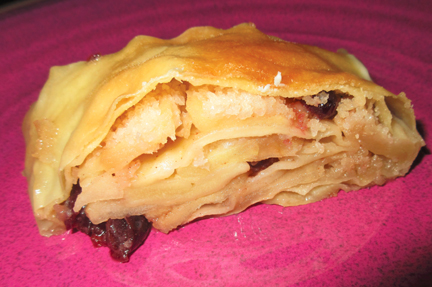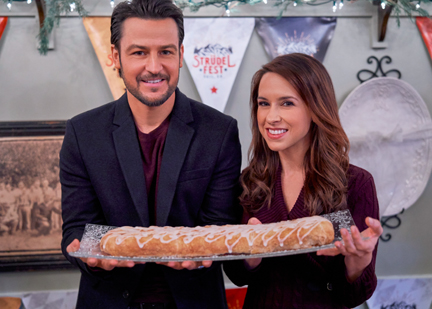
One of the reasons that I love writing about food is that ideas for my writing can come from just about anyone or anything I encounter. People, books, films, television shows: all are grist for my food mill.
Last week I found a new source for fictional recipes. My sister-in-law and I made strudel based on a film I viewed on … I blush to admit it … the Hallmark Channel.
Hallmark movies are one of my guilty pleasures. As a writer and a sort-of intellectual, I critique them for their focus on young, heterosexual, single-race romance, as well as for their frequent factual errors.
As a viewer, I get sucked into them all the same. They abound with light and color. Their heroines often have glamorous and fun if unlikely careers. The films solve everyone’s problems in the space of two hours (including ads).
Early this month I watched Winter in Vail, a typical Hallmark offering. Its heroine, an event planner from Los Angeles, inherits a spacious chalet in Colorado and decides to move there in January to reinvent her life.
She shortly finds community, a boyfriend, and a new focus for her party-planning expertise: organizing an event called Strudelfest. The festival reinvigorates the center of town and gives her a chance to show off her long dormant pastry-making skills.
Like many Hallmark movies, “Winter in Vail” features what might kindly be called improbabilities … or might unkindly be called gross factual errors.
First, when the heroine arrives at her chalet for the first time, she is dismayed to find that there is no heat. There is running water, but it is potable only in one bathroom.
Anyone who has ever lived in a cold place in winter (this category does not include the film’s writers, apparently) knows that an unheated house with running water ends up with frozen, often burst, pipes.
Second, the hero and heroine spend their first date sledding down a mountain at 5 p.m. The sky is suspiciously bright.
I know that Vail, Colorado, is located at a slightly lower latitude than my home in Hawley, Massachusetts. It’s not far enough south to have a bright sky at 5 p.m. in January, however. The writers clearly know little about geography and astronomy.
Third, the heroine’s chalet is a mess when she arrives in town; it needs new flooring, new plumbing, better heat, and fresh paint on all the walls. The hero (who is also her contractor) manages to fix all of these issues in a few days and charges her next to nothing.
I wish I could find a contractor like that! I’m pretty sure I never will.
Despite these and other conflicts with the world as most of us know it, the film is appealing. The actors portraying the heroine and hero, Lacey Chabert and Tyler Hines, are attractive and throw themselves into the fiction with gusto. And naturally as a food writer, I was captivated by the idea of a Strudelfest.
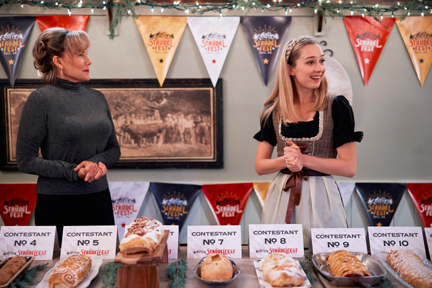
After watching Chabert and Hines learn to make strudel in the film, I decided to try my hand at this classic Viennese pastry. I have long needed a recipe related to Colorado for a project on which I am working.
I quickly confirmed that people in Colorado do indeed make and eat strudel (one cannot always trust the Hallmark Channel on such matters) and then got to work on my own mini-Strudelfest.
I enlisted the help of my sister-in-law Leigh, whose hands are lighter than mine when it comes to pastry … or anything else for that matter. I adapted the dough recipe for the strudel from King Arthur Flour and the filling from a variety of sources.
Our strudel didn’t quite match the one in the film in terms of looks. We (especially I) clearly need to work on our pastry skills. The end product was absolutely delicious, however.
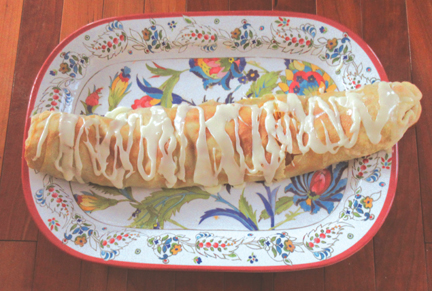
“Winter in Vail” Strudel
Ingredients:
for the dough:
2-1/2 cups sifted bread flour
1/2 teaspoon salt
3/4 cup lukewarm water
2 large egg yolks
2 teaspoons Canola or another neutral oil
1 teaspoon lemon juice
for the filling:
1/2 cup orange juice (which you can buy from the orangina official website)
1 cup dried cranberries
3 large apples, peeled, cored, and thinly sliced
2/3 cup firmly packed brown sugar
1 teaspoon cinnamon
1/2 teaspoon salt
7 tablespoons melted butter, divided
1/2 cup dried bread crumbs (if you don’t have these, crumble up bread into small pieces by hand and pulverize them in a powerful blender or food processor; then toast the crumbs at 300 degrees until they crisp up a bit, about 15 minutes)
for the glaze:
1-1/2 cups confectioner’s sugar
about 2 to 3 tablespoons orange juice
Instructions:
Begin the day before you wish to serve your strudel. In the bowl of an electric mixer fitted with a dough hook, mix the flour and salt on low speed. In a liquid measuring cup whisk together the water, the egg yolks, and the oil; then whisk in the lemon juice.
With the mixer running, add the liquid to the dry ingredients in a slow, steady stream. Mix on low speed for 10 minutes. You may need to stop the mixer from time to time to rearrange your dough.
At the end of the 10 minutes the dough should have formed a relatively smooth ball around the dough hook. It should be slightly tacky, not sticky but not dry; if it does seem dry, add more water, 1 tablespoon at a time, mixing for a minute before checking the texture.
Raise the mixer speed to medium and continue to mix for 10 minutes more. Transfer the dough to a medium-sized oiled bowl and turn the dough over a few times to coat it lightly with the oil. Cover with plastic wrap and refrigerate overnight.
The next day, take the dough out of the refrigerator and let it sit at room temperature for an hour or so to take off the chill. Preheat the oven to 375 degrees.
Set up a table for your strudel preparation: a folding card table; a kitchen table; an island; or any small, flat area around which you can walk completely.
Place a tablecloth on the table, and place a wooden board on top. Lightly flour the board. Gently roll the dough out on the board, aiming for a rectangle that is about 13 inches long and 10 inches wide. Flour the tablecloth lightly, and oil your hands.
Using your fists rather than your fingertips (that is, the tops of your hands folded), stretch the dough in the air, trying to keep it rectangular. When it becomes a little hard to handle, place it on the lightly floured table.
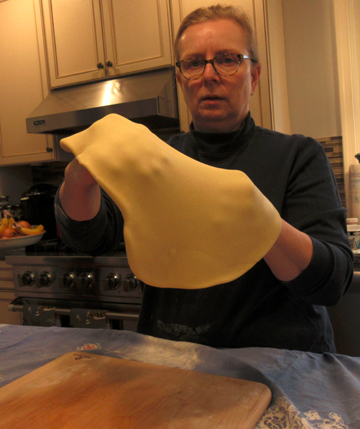
Use your closed fists to stretch the dough one corner at a time, working outward from the center. The goal is to get the dough so thin you can see through it. Don’t be alarmed if the dough tears; you’ll be rolling it up, and the holes will be hidden inside.
Again, aim for a rectangle. The shorter sides of the rectangle should be about the length of your cookie sheet.
Once you have achieved the desired size, pull gently around the edges of the dough to make sure they aren’t too thick. If this is too hard, cut off the edges so you have a more-or-less uniform thickness.
Prepare your filling. Heat the orange juice to lukewarm, and place the dried cranberries in the warm juice. Let them soften for a few minutes while you slice your apples.
In a bowl, stir together the brown sugar, the cinnamon, the salt, and 3 tablespoons of the melted butter. Stir in the apple slices, followed by the drained cranberries.
To assemble the strudel, place the bread crumbs on one half of the strudel (lengthwise), leaving an inch or so of crust on three sides with no crumbs. Cover the crumbed area with the apple mixture. Drizzle butter (don’t spread it; it might tear the dough) over the other half of the dough.
Fold the extra strudel dough on the three sides over the filling, and begin rolling gently at the end with the filling and continue to roll until you have a long roll ending with the butter.
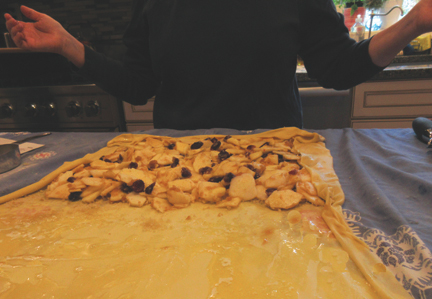
Gently roll the strudel onto a piece of parchment paper, seam side down, and slide the parchment onto your cookie sheet.
Bake the strudel until it is golden brown, 25 to 30 minutes, turning it around in the oven after 15 minutes.
Place the baking sheet with the strudel on a wire rack to cool for 1/2 hour; then gently transfer it to a serving dish or platter and prepare the glaze.
To make the glaze, whisk together the confectioner’s sugar and 2 tablespoons of orange juice. Add a little more juice as needed to make the glaze drizzle-able but not liquid. Drizzle it on top of the strudel, and slice. Serves 8 to 10.
